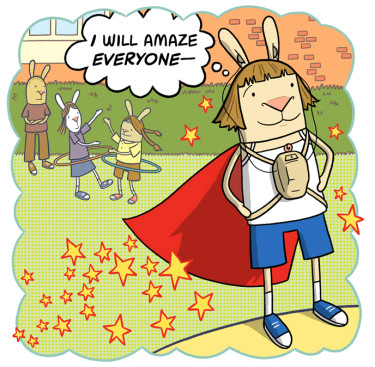Author of “El Deafo,” CeCe Bell, reveals the book’s backstory
by Beth
 We are extremely pleased to introduce Cece Bell as a guest blogger today. Her graphic novel El Deafo is a loose biographical account of her childhood living with deafness, and it won a Newbery honor this year.
We are extremely pleased to introduce Cece Bell as a guest blogger today. Her graphic novel El Deafo is a loose biographical account of her childhood living with deafness, and it won a Newbery honor this year.
by Cece Bell
One of the more uncomfortable experiences I sometimes have as a deaf person is when I cannot understand the person speaking to me. And so, the person speaking to me gets annoyed with me, or even angry. Perhaps the person thinks that I am not listening, or that I don’t care. They don’t know the real reason, which is simply that I cannot hear them — or anything, for that matter — very well.
The easiest way to deal with a situation like this is to say, “I’m sorry. I can’t hear very well. Could you repeat that?” I am able to do that now. But for years and years, I couldn’t. I was too ashamed.
About seven years ago, I was in the check-out line at our local grocery store. Annette the cashier was never all that pleasant — her gruff manner made her really hard to lip-read. That day I was preoccupied with who knows what, and so I wasn’t as attentive in my lip-reading as I usually am. I couldn’t understand anything she was saying.
As I floundered around trying to make sense of all the usual “find everything OK paper or plastic have any coupons that’ll be $120.43 debit or credit” Annette became increasingly agitated with me. Her usual gruffness turned into real anger. I was flustered, and after paying for my groceries I rushed with my cart out of the store.
I was halfway to my car in the vast, hot parking lot when Annette suddenly reappeared at my shoulder and spat out, “You FORGOT your RECEIPT.” I thanked her through gritted teeth and was completely in tears by the time I got to my car.
In a haze of frustration and crying my eyes out, I replayed that unfortunate interaction over and over the whole drive home and fantasized about what I should have done and what I should have said. Why didn’t I just pull out my hearing aids, shove them in Annette’s face, and say, “I can’t understand you. I’m deaf. See?”
But that’s not what I did, because I’ve never done something like that. I had been deaf for over thirty years back then and I couldn’t say those words—I just couldn’t.
When I got home, I told my husband Tom what had happened. He immediately called the grocery store to complain. Tom said everything I should have said. When he hung up, he informed me that the manager had had lots of trouble with Annette, and so he was going to demote her to the meat department.
A victory for sure, but a hollow one for me. I should have been the one complaining to the manager. I should have fought this battle myself.
For days afterward, I thought about Annette and how terrible she had made me feel. I thought about how terrible I had made myself feel for not speaking up. I wanted to vent, so I started a blog called El Deafo. El Deafo was the name of my childhood superhero alter ego, the one who said the things and did the things I wish I had said and done, but only in my daydreams.
Starting that blog meant I was ready to stop being ashamed of something that isn’t at all shameful in the first place. I was ready to face the music, even if I couldn’t hear it that well. I was ready to tell the world. I AM DEAF.
That blog was the spark for my graphic novel, El Deafo, an autobiographical graphic novel that chronicles my childhood experiences with deafness and friendships. Writing El Deafo forced me to re-examine the shame I had felt and to put that shame behind me. El Deafo tells the world that I AM DEAF, and the incredibly positive responses that I have received since its publication have proven one thing: sharing your differences with the world does indeed make you a stronger person. I made my own life so much better when I wrote El Deafo. I can only hope that it might help others, too.






